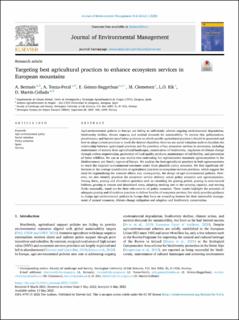| dc.description.abstract | Agri-environmental policies in Europe are failing to sufficiently address ongoing environmental degradation, biodiversity decline, climate impacts, and societal demands for sustainability. To reverse this, policymakers, practitioners, and farmers need better guidance on which specific agricultural practice/s should be promoted and how to adapt current practices to reach the desired objectives. Here we use social valuation tools to elucidate the relationship between agricultural practices and the provision of key ecosystem services in mountains, including maintenance of scenery from agricultural landscapes, conservation of biodiversity, regulation of climate change through carbon sequestration, production of local quality products, maintenance of soil fertility, and prevention of forest wildfires. We use as case studies two contrasting but representative mountain agroecosystems in the Mediterranean and Nordic regions of Europe. We analyze the best agricultural practices in both agroecosystems to reach the targeted environmental outcomes under three plausible policy scenarios. We find significant differences in the average contribution of agricultural practices to ecosystem services provision, which suggest the need for regionalizing the research efforts and, consequently, the design of agri-environmental policies. However, we also identify practices for ecosystem service delivery across policy scenarios and agroecosystems. Among these, grazing and silviculture practices such as extending the grazing period, grazing in semi-natural habitats, grazing in remote and abandoned areas, adapting stocking rate to the carrying capacity, and moving flocks seasonally, stand out for their relevance in all policy scenarios. These results highlight the potential of adequate grazing and silviculture practices to deliver bundles of ecosystem services. Our study provides guidance to design agri-environmental policies in Europe that focus on rewarding farmers for their sustainable management of natural resources, climate change mitigation and adaption and biodiversity conservation Agri-environmental policy Social valuation Policy scenarios Spain Norway | |
